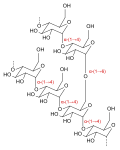Beer chemistry
Beer Chemistry[edit]
| Branches of chemistry | ||||||||||
|---|---|---|---|---|---|---|---|---|---|---|
|
Beer is an alcoholic beverage that has been enjoyed by humans for thousands of years. It is made through a process called brewing, which involves the fermentation of cereal grains, such as barley, along with water, hops, and yeast. The chemistry behind beer production is fascinating and plays a crucial role in determining the flavor, aroma, and overall quality of the final product.
Ingredients[edit]
The main ingredients in beer are water, malted barley, hops, and yeast. Each of these components contributes to the chemical reactions that occur during brewing.
Water is the primary component of beer, making up about 90-95% of the final product. It serves as a solvent, extracting the flavors and sugars from the malted barley and hops. The mineral content of water can also influence the taste and character of the beer.
Malted barley is the source of fermentable sugars in beer. Barley grains are malted by soaking them in water and allowing them to germinate. This process activates enzymes that convert the starches in the barley into sugars, which can be fermented by yeast.
Hops are flowers that add bitterness, flavor, and aroma to beer. They contain essential oils and resins that contribute to the characteristic hoppy taste. Hops also act as a natural preservative, inhibiting the growth of bacteria and other microorganisms.
Yeast is responsible for the fermentation process, where the sugars in the malted barley are converted into alcohol and carbon dioxide. Yeast also produces various flavor compounds, such as esters and phenols, which contribute to the unique taste and aroma of different beer styles.
Brewing Process[edit]
The brewing process involves several chemical reactions that transform the raw ingredients into beer. These reactions are facilitated by enzymes, heat, and the action of yeast.
First, the malted barley is milled and mixed with hot water in a process called mashing. This activates enzymes in the barley that break down the starches into fermentable sugars. The resulting liquid, known as wort, is then separated from the solid grain material.
The wort is then boiled, and hops are added at different stages to achieve the desired bitterness and flavor. Boiling also helps sterilize the wort and extract hop oils. After boiling, the wort is rapidly cooled to a temperature suitable for yeast fermentation.
Once the wort has cooled, yeast is added, and fermentation begins. Yeast consumes the sugars in the wort, producing alcohol and carbon dioxide as byproducts. This process typically takes several days to weeks, depending on the beer style and desired alcohol content.
After fermentation, the beer is often conditioned or aged to allow flavors to develop and any remaining yeast or sediment to settle. It is then carbonated, either naturally through secondary fermentation or artificially through carbonation methods.
Categories[edit]
References[edit]
<references group="" responsive="1"></references>
-
12-hopfenwiegen
-
Dextrin skeletal
-
S-Humulone Isomerization
-
Ethanol fermentation
-
Fluorescence in beer at 450nm illumination
Ad. Transform your life with W8MD's Budget GLP-1 injections from $75


W8MD offers a medical weight loss program to lose weight in Philadelphia. Our physician-supervised medical weight loss provides:
- Weight loss injections in NYC (generic and brand names):
- Zepbound / Mounjaro, Wegovy / Ozempic, Saxenda
- Most insurances accepted or discounted self-pay rates. We will obtain insurance prior authorizations if needed.
- Generic GLP1 weight loss injections from $75 for the starting dose.
- Also offer prescription weight loss medications including Phentermine, Qsymia, Diethylpropion, Contrave etc.
NYC weight loss doctor appointmentsNYC weight loss doctor appointments
Start your NYC weight loss journey today at our NYC medical weight loss and Philadelphia medical weight loss clinics.
- Call 718-946-5500 to lose weight in NYC or for medical weight loss in Philadelphia 215-676-2334.
- Tags:NYC medical weight loss, Philadelphia lose weight Zepbound NYC, Budget GLP1 weight loss injections, Wegovy Philadelphia, Wegovy NYC, Philadelphia medical weight loss, Brookly weight loss and Wegovy NYC
|
WikiMD's Wellness Encyclopedia |
| Let Food Be Thy Medicine Medicine Thy Food - Hippocrates |
Medical Disclaimer: WikiMD is not a substitute for professional medical advice. The information on WikiMD is provided as an information resource only, may be incorrect, outdated or misleading, and is not to be used or relied on for any diagnostic or treatment purposes. Please consult your health care provider before making any healthcare decisions or for guidance about a specific medical condition. WikiMD expressly disclaims responsibility, and shall have no liability, for any damages, loss, injury, or liability whatsoever suffered as a result of your reliance on the information contained in this site. By visiting this site you agree to the foregoing terms and conditions, which may from time to time be changed or supplemented by WikiMD. If you do not agree to the foregoing terms and conditions, you should not enter or use this site. See full disclaimer.
Credits:Most images are courtesy of Wikimedia commons, and templates, categories Wikipedia, licensed under CC BY SA or similar.
Translate this page: - East Asian
中文,
日本,
한국어,
South Asian
हिन्दी,
தமிழ்,
తెలుగు,
Urdu,
ಕನ್ನಡ,
Southeast Asian
Indonesian,
Vietnamese,
Thai,
မြန်မာဘာသာ,
বাংলা
European
español,
Deutsch,
français,
Greek,
português do Brasil,
polski,
română,
русский,
Nederlands,
norsk,
svenska,
suomi,
Italian
Middle Eastern & African
عربى,
Turkish,
Persian,
Hebrew,
Afrikaans,
isiZulu,
Kiswahili,
Other
Bulgarian,
Hungarian,
Czech,
Swedish,
മലയാളം,
मराठी,
ਪੰਜਾਬੀ,
ગુજરાતી,
Portuguese,
Ukrainian



